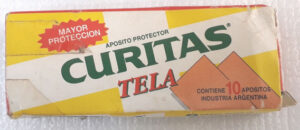¿Curita o Bandita?
By Gloria M. Rivera
As a Spanish translator and interpreter in the US I work with different variants of Spanish. That is why I enjoy collecting words from different countries. You never know when they may come in handy some day.
This time, I decided to talk about a word that is very used in medicine: adhesive band.
- Curita: Is the preferred term in the Americas.
- Argentina, Costa Rica, Guatemala, Panama, Peru, Puerto Rico, Uruguay, and Venezuela
Bolivia, Colombia, Nicaragua (also cura) - Honduras and México (also bandita)
- Cuba (also bendita)
- Chile: it is mostly used as parche curita
- Argentina, Costa Rica, Guatemala, Panama, Peru, Puerto Rico, Uruguay, and Venezuela

- Tirita: Is the term used in Spain.
Both terms, curitas and tiritas, come from brand names: Curitas ® and Tiritas®. When you use a brand name as a generic term, you’re using a proprietary eponym or a generic trademark. It is the same thing that happened with aspirin that used to be a proprietary term from Bayer or paper tissues from Kleenex.
Same thing happens when we go into English and we communicate with someone from the US or England about an adhesive band or a self-adhesive bandage.
- United States: band-aid
- United Kingdom: sticking plaster, medical plaster.
Just like curita and tirita in Spanish, band-aid comes from Band-Aid® , a brand name by Johnson & Johnson Company. On the other hand, plaster comes from the sticky paste used to keep the bandage in place.

But, what do we do when we do not know what word to choose?
When translating we are usually informed about the target audience and I have a habit of asking about it for all my projects. In case we are not, I recommend asking the client or project manager (PM). This may be something the client did not think about as they may not be familiar with the intricacies of languages or the PM may be new or forgot to let us know. In any case, this may help avoid misunderstandings or money since an ad was not placed or printed.
When interpreting, I just use the most common term. If the patient does not sound Spanish, I go with curita. If they sound like they know where to find the best paella in town, I go with tirita. If the patient uses a different word, like bandita, then I just continue using the word offered by them. In the end, our personal preferences should not come before our client’s word choice when possible.
As usual, I have left a list of resources below if you feel like learning more about this topic.
Thank you for reading!
If you enjoyed my blog post or have a different term you would like to share with the group, feel free to contact me.
xo
Gloria
Sources:
- Diccionario de la lengua española de la Real Academia Española de la Lengua (DLE): https://dle.rae.es/curita?m=form
- DLE: https://dle.rae.es/tirita?m=form
- Diccionario de americanismos: https://www.asale.org/damer/curita
- Diccionario de Términos Médicos (DTM) de la Real Academia Nacional de Medicina de España: https://dtme.ranm.es/buscador.aspx?NIVEL_BUS=3&LEMA_BUS=curita
- DTM: https://dtme.ranm.es/buscador.aspx?NIVEL_BUS=3&LEMA_BUS=tirita
- Merriam-Webster: https://www.merriam-webster.com/dictionary/Band-Aid
- Cambridge Dictionary: https://dictionary.cambridge.org/us/dictionary/english/plaster
- Farmacia (Chile): https://www.cruzverde.cl/higiene-y-cuidado-personal/
- Tiritas (Spain): https://www.tiritas.es/tiritas/classic
- Curitas (Mexico): https://www.curitas.com.mx/productos/plasters-and-pads
- Band-Aid: https://www.band-aid.com
- Not One-Off Britishisms: https://notoneoffbritishisms.com/2015/07/10/plaster/
- How a Brand Name becomes Generic: https://www.nytimes.com/2019/06/24/smarter-living/how-a-brand-name-becomes-generic.html#:~:text=June%2024%2C%202019,more%20simply%2C%20a%20generic%20trademark.

